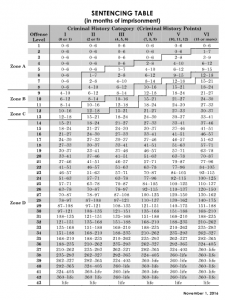When determining possible, criminal sentencing ranges and placement options at the federal level, one only look so far as the federal sentencing guidelines and the federal sentencing table.
See a blog on the guidelines and sentencing table here. Here is the table as well:

While the sentencing table lays out the advisory sentencing ranges that judges look to in determining the total length of the sentence to be imposed based on the crime committed, one of the most common questions we get asked is, “now that I know how long my sentence will be, where do I have to serve that time? Is that jail, home detention, or probation?”
The options available for placement depend on which “zone” the defendant falls within after incorporating the statutory advisory sentencing level of the crime they committed and their criminal history category. When you combine those two factors, the advisory sentencing range will fall within a zone. The zones and the available placement options are below:
______________________________________
Zones as Found in Criminal History Category I (0 or 1 priors):
Zone A: Offense Levels 1 – 8 with sentencing ranges of 0-6 months
Zone B: Offense Levels 9-11 with sentencing range minimums of 4 months to 14 months max
Zone C: Offense Levels 12 & 13 with sentencing range minimums of 10 months to 18 months max
Zone D: Offense Levels 14+ with sentencing ranges of 15 months minimum or higher
Zones as Found in Criminal History Category II (2 or 3 priors):
Zone A: Offense Levels 1-5 with sentencing ranges of 0-6 months
Zone B: Offense Levels 6-10 with sentencing range minimums of 1 months to 14 months max
Zone C: Offense Levels 11 & 12 with sentencing range minimums of 10 months to 18 months max
Zone D: Offense Levels 13+ with sentencing ranges of 15 months minimum or higher
Zones as Found in Criminal History Category III (4, 5 or 6 priors):
Zone A: Offense Levels 1 – 4 with sentencing ranges of 0-6 months
Zone B: Offense Levels 5-9 with sentencing range minimums of 1 months to 14 months max
Zone C: Offense Levels 10 & 11 with sentencing range minimums of 10 months to 18 months max
Zone D: Offense Levels 12+ with sentencing ranges of 15 months minimum or higher
Zones as Found in Criminal History Category IV (7, 8, or 9 priors):
Zone A: Offense Levels 1 – 3 with sentencing ranges of 0-6 months
Zone B: Offense Levels 4-7 with sentencing range minimums of 2 months to 14 months max
Zone C: Offense Levels 8 & 9 with sentencing range minimums of 10 months to 18 months max
Zone D: Offense Levels 10+ with sentencing ranges of 15 months minimum or higher
Zones as Found in Criminal History Category V (10, 11, or 12 priors):
Zone A: Offense Levels 1 & 2 with sentencing ranges of 0-6 months
Zone B: Offense Levels 3-6 with sentencing range minimums of 2 months to 15 months max
Zone C: Offense Levels 7 with sentencing range minimums of 12 months to 18 months max
Zone D: Offense Levels 8+ with sentencing ranges of 15 months minimum or higher
Zones as Found in Criminal History Category VI (13+ priors):
Zone A: Offense Levels 1 with sentencing ranges of 0-6 months
Zone B: Offense Levels 2-5 with sentencing range minimums of 1 months to 15 months max
Zone C: Offense Levels 6 with sentencing range minimums of 12 months to 18 months max
Zone D: Offense Levels 7+ with sentencing ranges of 15 months minimum or higher
______________________________
But, within these zones, what placements options are there? Those are examined below:
Zone A: (jail not required)
- Probation only, no confinement
- Intermittent confinement, community confinement, home detention, and/or a
- Fine as the total punishment
Zone B: (jail required for at least one month + other conditions)
- Probation plus intermittent confinement, community confinement, home detention
- Imprisonment of at least one month plus supervised release plus bullet points above and/or
- Imprisonment only
Zone C: (jail required for at least half the minimum term + other conditions)
- Imprisonment of at least one-half of the minimum terms plus supervised released involving intermittent confinement, community confinement, and/or home detention
- Imprisonment only
Zone D: (jail only)
- Imprisonment only
*Community confinement = community treatment center, halfway house, mental health facility, substance abuse facility
*Intermittent confinement = custody in intervals (weekends, etc.)
As you can clearly see, the more criminal history a defendant has and the higher the offense level, the less options are available for alternative placement. If you look at the sentencing table, you’ll notice that Zones A, B, and C are relatively small, and Zone D encompasses a large portion of the table. So, imprisonment is much more prevalent at the federal level.
Should you or a loved one be facing a federal charge, give the experienced Federal Indiana Criminal Defense Attorneys at Banks & Brower a call today. We are available 24/7/365 at info@banksbrower.com or by phone at 317.870.0019.
